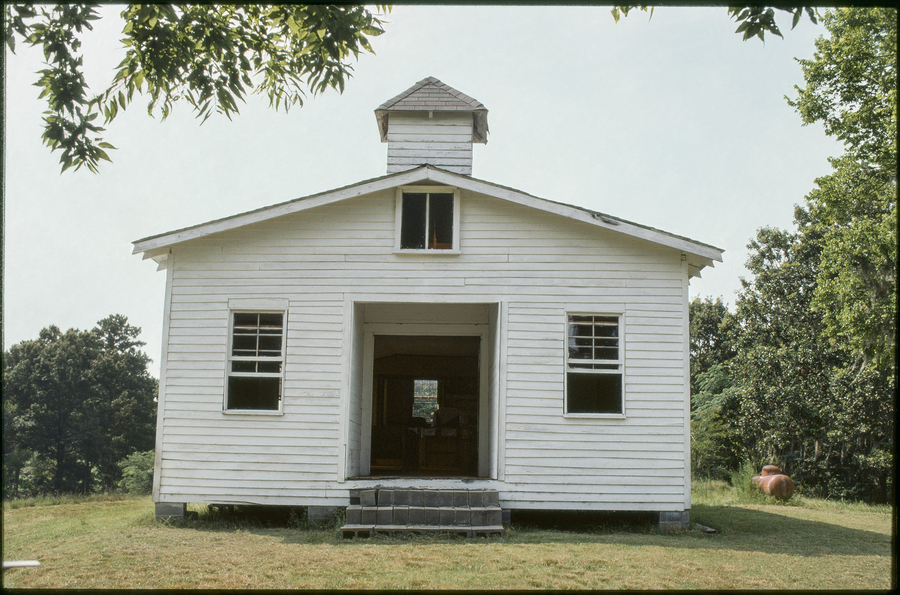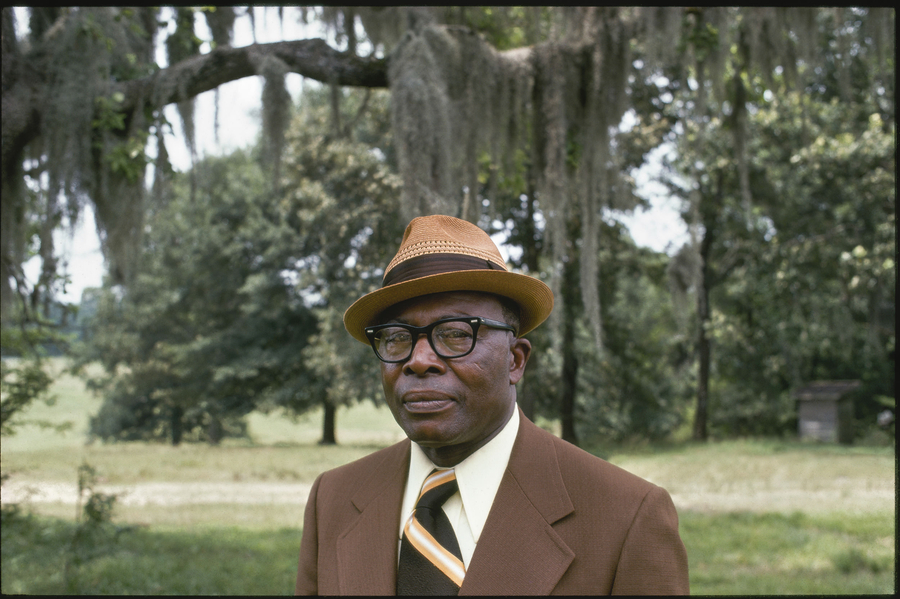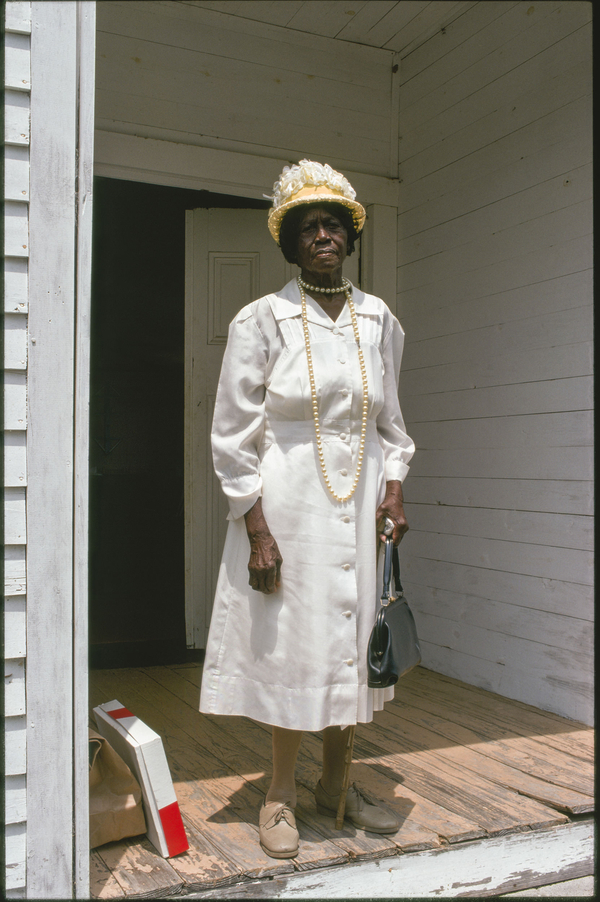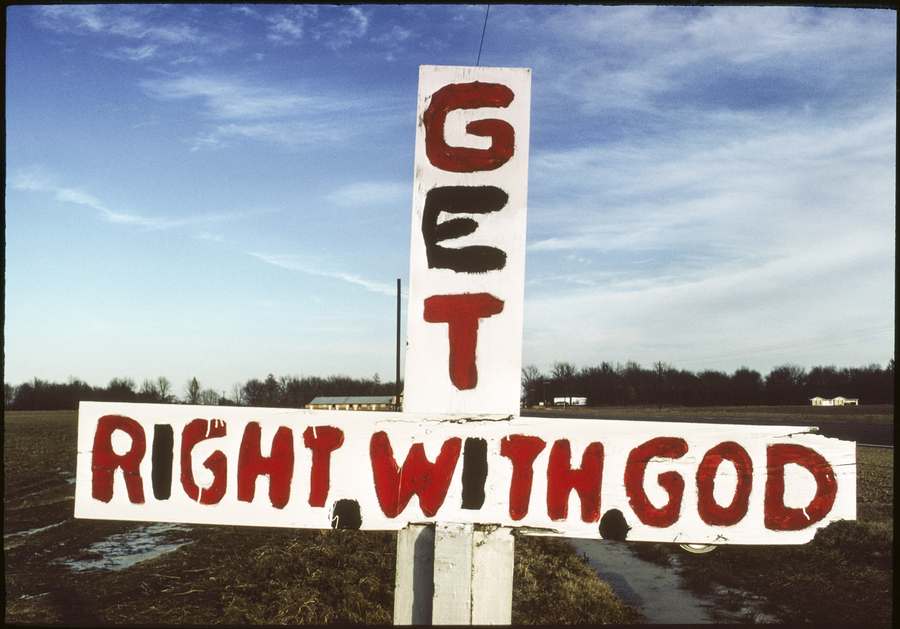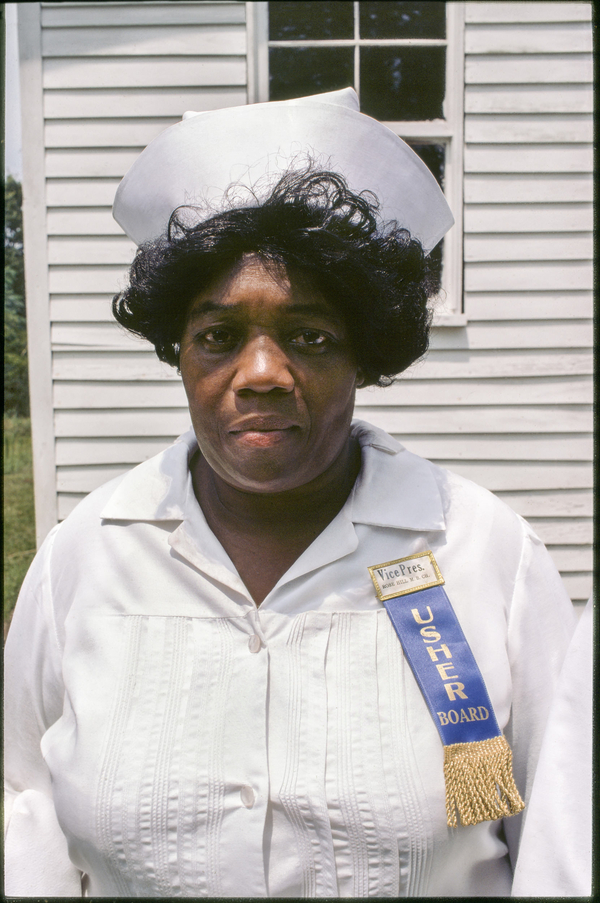William R. Ferris is the Joel R. Williamson Eminent Professor of History Emeritus and Senior Associate Director Emeritus of the Center for the Study of the American South at the University of North Carolina.
Joint publication with Journal of Southern Religion available here.
An Introduction
This joint issue of the Journal of Southern Religion and Material and Visual Culture of Religion Journal is an exciting moment for the study of religion in the American South. Described by Flannery O’Connor as “Christ-haunted,” southern identity is and always has been shaped by religion.1 The still familiar sight of churches and hand-painted religious signs along highways and roads are powerful reminders of religion throughout the region. As the field of Southern Studies has evolved, so has our understanding of religion and its expression in material and visual culture in the region.
Four excellent articles in this issue demonstrate the historic and geographic range of religion in the American South. Samuel Stella’s “The Second Great Awakening and the Built Landscape of Missouri” opens with a photograph and discussion of New Lebanon Cumberland Presbyterian Church which “sits unused on Missouri Highway A.” Stella builds on the pioneering work of material culture scholar and folklorist Henry Glassie and Don Mathews, the great historian of southern religion, as he examines how the gable-end church architectural form represents “Little Dixie,” a region in Missouri that was settled by families from Kentucky, Tennessee, and Virginia. These settlers tried to recreate a plantation system in Missouri that was based on slavery in those three states.
Emily Wright’s “‘A Doorkeeper in the House of my God,’ Female Stewardship of Protestant Sacred Spaces in the Gulf South, 1830-1861” showcases how white slave-owning women and black enslaved women built churches in the Deep South. Wright details how forced black female physical labor and white female fundraising built churches in a slave society. With their collective labor, both of the body and the mind, 108 churches were built in the Gulf South from 1835 to 1861.
In “Uncle Tom’s Bibles: Bibles as Visual and Material Objects from Antebellum Abolitionism to Jim Crow Cinema,” Edward Blum reminds us how Uncle Tom defied his master Simon Legree by hiding his Bible in his pocket as Legree tells him, “I’m your church now!”2 Blum argues that by promoting the Bible as a means to reach both black slaves and white slaveowners, Harriet Beecher Stowe shaped a racist stereotype that infantalized blacks. Frederick Douglass forcefully rejected Stowe’s approach to the Bible as “a sham, a delusion and a snare.”3
“Horseshoe Crosses and Muddy Boots: Material Culture and Rural Masculinity in Cowboy Churches” is a fascinating history of the American Fellowship of Cowboy Churches in Texas. Sarah Moczygemba traces the roots of these churches to nineteenth-century cowboy camp meetings and to barn-like churches with their crosses made of old horseshoes, reclaimed wood, and barbed wire. These “objects” symbolized Christian worship for cowboys. Texas stands at “the intersection of the American South, the American West, and the Mexican-American borderlands,” and cowboy churches draw on southern theology, masculinity, and iconic material representations of the West. Their congregations are largely white, with a smaller number of Latinx members.
My introduction to southern religion and its material culture was on a farm in Warren County, Mississippi. When I was five years old, a black woman named Mary Gordon took me to Rose Hill Church near our home on the first Sunday of each month. There I learned to sing hymns and to appreciate the chanted sermons of Reverend Isaac Thomas. There were no hymnals in the church, and I later realized that when the families were gone, the music would also disappear. To preserve that world, I later began to record and photograph the church services. That experience inspired my career as a folklorist and my study of the American South.
- 1Flannery O’Connor, “Some Aspects of The Grotesque in Southern Fiction,” in Mystery and Manners Occasional Prose, ed. Sally Fitzgerald and Robert Fitzgerald (New York: Farrar, Straus & Giroux, 1969), 44.
- 2Harriet Beecher Stowe, “Chapter XXXI: The Middle Passage,” in Uncle Tom's Cabin, Or, Life Among the Lowly (Boston: John P. Jewett and Company, 1851), 127.
- 3Frederick Douglass, “I Denounce the So-Called Emancipation as a Stupendous Fraud,” speech, in Frederick Douglass: Selected Speeches and Writings (Chicago: Lawrence Hill Books, 1999), 720.
In his sermons, Reverend Thomas challenged his congregation to consider the gates of both Heaven and Hell, to confront the dark night of the soul, to experience sickness unto death. I later connected his voice to that of Dylan Thomas who urged his father, “Do not go gently into that good night. Rage, rage against the dying of the light.”1 Reverend Thomas gave me a childhood religious foundation that allowed me to explore multiple religious voices including southern Baptist preachers—from Billy Graham to Jesse Jackson—theologian Reinhold Niebuhr in “Moral Man and Immoral Society,” Reverend Martin Luther King, and Highlander Center founder Miles Horton, all of whom I associated with the American South.
- 1Dylan Thomas, “Do Not Go Gentle into That Good Night,” in The Collected Poems of Dylan Thomas, ed. Daniel Jones (New York: New Directions, 1953), 239.
Reverend Thomas assured me that his church doors would “always swing open on the hinges of welcome” when I came.1 As a child, he knew that he wanted to preach. “I had a zeal in me when I was five or six years old to preach, but I really didn’t think it would lead up to the position which I hold now…. Everything that would die that our parents was raising—animals or chickens—almost anything that would die, I’d have church over. I’d have a funeral, and I would always be the preacher to preach those animals’ funerals.”2
Reverend Thomas influenced my undergraduate study at Davidson College, where I taught Sunday School in a black Presbyterian Church across the tracks from the white church on campus, at Union Theological Seminary in New York City where I worked with SNCC organizers of the Mississippi Freedom Summer, and at the University of Pennsylvania, where I wrote my PhD dissertation on “Black Folklore from the Mississippi Delta.”
Those foundational experiences framed my understanding of the American South through the lens of religion and material culture. The voices I encountered in my childhood and in my education revealed to me how memory and sense of place define southerners. Their stories, their music, and their material culture were worlds that I embraced in my teaching and writing.
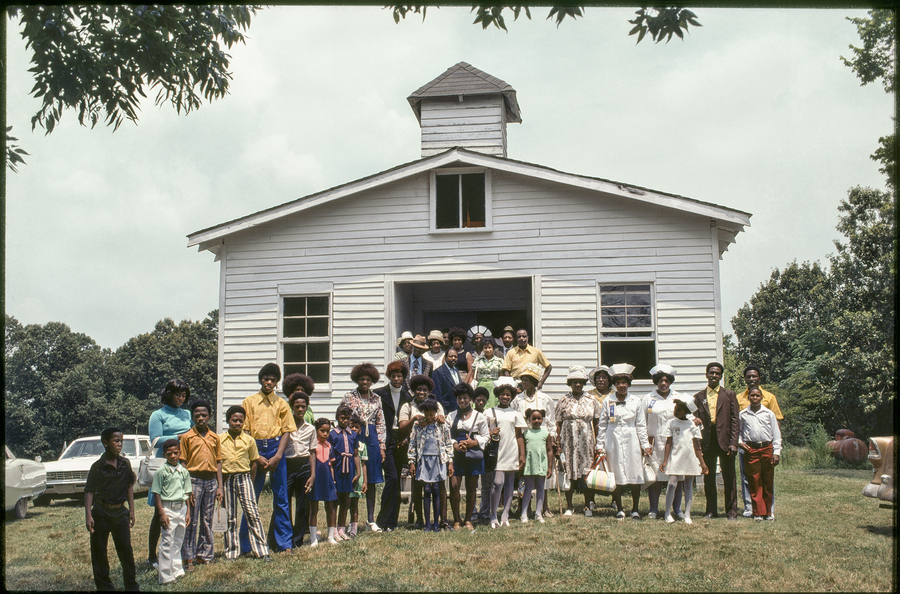
Figure 3. Rose Hill Church and Congregation. Left to right. Front row: Robert McGowan, Aaron “Dickie” Thomas (green shirt), John Henry Wright (gold shirt), Alfred Lee McGowan (white shirt), unidentified woman in green, Brenda Fay Appleton (pink and blue dress), Ida Thomas (blue dress with pink in center), Dessie “Ree” Thomas (green dress with white collar), Diane Wright Smith, Larry “L.S.” Huband, Mary “Liz” Martin (pink blouse), Mary Ellen McGowan (under Mary Martin’s hands), Patricia “Pat” Price (with bag), Allen “Man” McGowan, Annie “Ann” McGowan (white dress and white hat), Cathy McGowan (green dress), Amanda Gordon (standing in white dress behind Cathy McGowan), unidentified lady with bag, Bertide Smith (yellow dress and white hat), Dora “Red” Russell (white dress with usher ribbon and white hat), Rosie Wallace (white dress with usher ribbon and white hat), Rosie McGowan (small girl in front in white dress with usher ribbon and white hat), Allen McGowan (brown suit and gold shirt), Alton McGowan (gold shirt), unidentified young boy in white shirt. Left to right, in doorway: Mary “Monk” Gordon (white hat), Harvey Bass (man in hat), unidentified man without hat, Martha “Tet” Appleton (white dress and hat), Beatrice McGowan (behind Martha Appleton), Betty Ann Thomas (dark blue dress), Lucindy McGriggs (white hat), Mary Lee Appleton (green dress), unidentified man in hat, Steve Washington (gold shirt). Rose Hill Church, Fisher Ferry Road, Warren County, Mississippi, 1975.
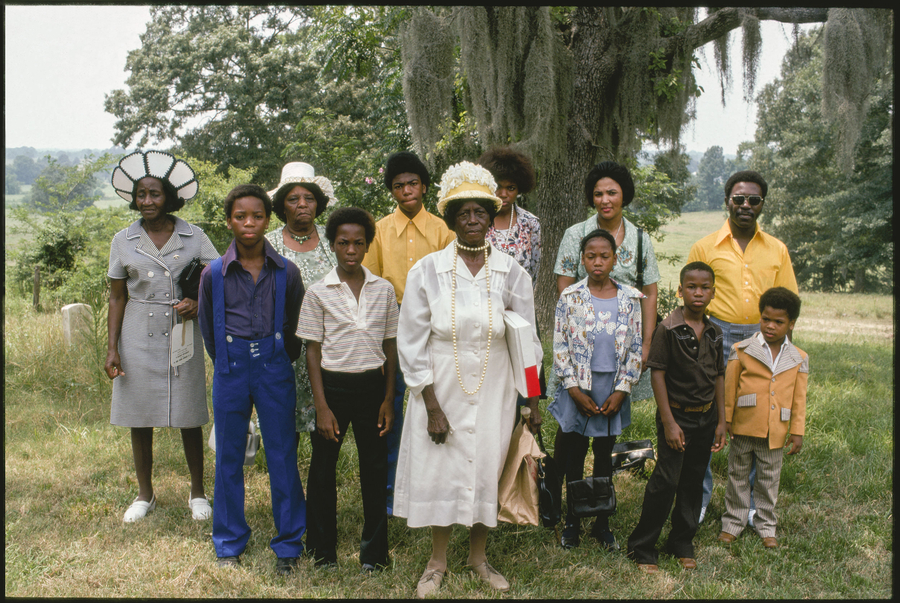
Figure 4. Left to right, rear row: Lucindy McGriggs, Mary Gordon, John Henry Wright, Diane Wright Smith, Beatrice Wright McGowan, Alton McGowan. Left to right, front row: Sammy Wright, Alfred Lee McGowan, Amanda Gordon, Mary McGowan, Robert McGowan, Marvin McGowan, Rose Hill Church, Fisher Ferry Road, Warren County, Mississippi, 1975.
I learned that in the South sacred and secular are joined at the hip and can never be separated. B.B. King sang gospel songs in the church, before he “crossed over” to his career as a blues artist, and Roebuck “Pops” Staples was a blues performer before he and his family formed the Staple Singers gospel group.
Shelby “Poppa Jazz” Brown describes the porous line between sacred and secular in his tale about two brothers—Heaven and Hell—who agree that when they die, Heaven will come down and visit his brother in Hell. After his death, Heaven borrows wings from the Lord, flies down to the underworld, and discovers his brother Hell in a bar surrounded by beautiful women as he drinks whiskey and plays cards. In amazement, Heaven asks his brother, “They allow you to do that here?”1
To which his brother replies, “Yeah, Man. We pitches a bitch here. We pitches a bitch.”
After making love to one of the women, the brother takes his wings and flies back to Heaven, only to find the doors locked because he is late. He bangs on the door until he wakes up the Lord who comes and asks, “What do you want?”
Heaven replies, “Lord I just want to let you know one thing. I brought these damn wings back to you, and I’m going back down to hell where I belong. You can take these sons of bitches. Here they is.”
Poppa Jazz concludes his story, “So he went on back to hell. I ain’t lying either. I ain’t lying.”
Clearly the line between secular and sacred is never clear or final, even after death.
Similarly, Mary Gordon, a baptized member of Rose Hill Church, was deeply religious and described a vision in which she saw Jesus. “Looked like He was walking in clouds. He was way up in the sky. He had on a long white coat, and He was bare-feeted. I could see His bare feets, but I couldn’t see nothing under them. He was just walking, walking along in the air with a white coat touching down along His feet.”2
Mrs. Gordon also sang a parody of a religious hymn about preachers with the closing verses:
When I first moved to Memphis, Tennessee,
I was crazy about the preacher as I could be.
I went out on my front porch walking around.
I invite the preacher over to my house.
Washed his face, combed his head.
Next thing he wanted to do was slip in my bed.
I caught him by the head, man, and kicked him out the door.
I don’t allow no preachers around my house no more
Don’t allow.
Oh, when the Good Lord sets you free.3
Sacred and secular worlds coexist in intimate ways in the minds of both preachers and blues artists, and material culture reflects that intimacy. In his home in Tutwiler, Mississippi, blues singer Lee Kizart hung his guitar over a framed color picture of Jesus hanging from the cross. Kizart remarked that in his community, “They’ll say, ‘You know that old man toting that guitar yonder, he oughta be going to church.’
“That’s what everybody said about me, you know. But now, you take up the road,… In Chicago, down in the basement there in the churches, they got a saloon down there.…No doubt, it’s some big reverend’s place of business. He go down and shoot hisself good with some alcohol, and then he go back up and serve.
“But now, I don’t do that. I just serve one way. I won’t cross up church stuff with my stuff cause you can’t do everything and be saved.”1
While these voices and their oral tradition are a powerful window on religion, material and visual culture are equally important. Rose Hill Church was first built as a “brush arbor church” in which limbs cut from trees sheltered worshippers. A more secure building was later erected that still stands today, and remains a rural house of worship. Inside the building, worshippers cool themselves with fans provided by Dillon Funeral Home. The fans feature color images of Jesus, Martin Luther King, and Frederick Douglass on the front and the address and phone number of Dillon Funeral Home on the back.
Hand-painted, wooden signs nailed to churches and roadside signs with messages like “Get Right With God” remain familiar religious markers in the South. They capture oral and written tradition and proclaim the power of religion in the region.
- 1Ferris, Give My Poor Heart Ease, 95-96.
My understanding of religion in the American South deepened as I recorded, photographed, and filmed families and their churches over the years. Just as you never step into the same water in the Mississippi River twice, Southern Studies, religion, and material and visual culture constantly change. The world we study and how we study it have evolved in exciting ways.
The growth of Southern Studies degree-granting programs at institutions like the University of Mississippi, the University of North Carolina at Chapel Hill, the University of South Carolina, Vanderbilt University, and numerous other schools in the region has been dramatic. Within these schools, faculty and students document and study the region with digital technologies and methods that transform how we capture southern religious worlds and their material and visual culture.
Paralleling this change is the growth of archives, university presses, museums, and art galleries that focus on the American South. Archives like the Southern Folklife Collection and Southern Historical Collection at the University of North Carolina, the Blues Archive at the University of Mississippi, and collections at the Library of Congress and the Smithsonian Institution contain rich resources on southern religion. University Presses throughout the region, including the University of North Carolina Press in my home of Chapel Hill, publish exciting new research from southern studies scholars. And major collections of southern art are on display across the region from the Ogden Museum in New Orleans to the Morris Museum in Augusta, Georgia, to name a few. The Souls Grown Deep Foundation in Atlanta manages a large folk art collection assembled by William Arnett and supports artists, publications, and exhibitions.
Religion plays a central role in African American history and culture in the American South. Inspired by the opening of The National Museum of African American History & Culture (Washington, D.C.), significant new resources on African American history include the Capitol Square Civil Rights Memorial (Richmond, VA), Central High School Museum (Little Rock, AR), International Civil Rights Center & Museum (Greensboro, NC), Mississippi Civil Rights Museum (Jackson, MS), National Center for Civil and Human Rights (Atlanta, GA), the National Civil Rights Museum (Memphis, TN), the National Memorial for Peace and Justice (Montgomery, AL), and the Whitney Plantation Museum (Edgard, LA). Southern religion and its material/visual culture are prominently featured in all of these institutions.
Scholars like Henry Louis Gates at the Hutchins Center for African and African American Research at Harvard University, David Blight in the Department of African American Studies at Yale University, and Albert Raboteau in the Department of Religion at Princeton University have pioneered the study of the South and the rich contributions of African American people to its culture and history. And Charles Wilson at the University of Mississippi Center for Study of Southern Culture has pioneered the study of southern religion and its relationship to southern material culture, including church fans and a vial of Elvis’s sweat that declares, “His perspiration will be your inspiration.”
The field of Southern Studies has expanded beyond black and white families to finally include the region’s dynamic and complex Native American worlds. Malinda Maynor Lowry’s film Sounds of Faith captures her Lumbee family’s deep religious traditions and the importance of religio music in both their worship and their family gatherings. As a growing diversity of families continue to migrate to our region, Southern Studies is a truly global field of study, and faculty and students throughout the world are keenly interested in religion as a communicative expression of the American South.
This joint issue of the Journal of Southern Religion and MAVCOR Journal is a welcome and historic opportunity to both look back at the study of religion in the American South and to embrace exciting changes that lie ahead. The publication reassures us of the visionary work at the heart of these two important and deeply connected worlds of scholarship.
Notes
Imprint
10.22332/mav.med.2019.2
1. William R. Ferris, "Material and Visual Cultures of Religion in the American South," Mediation, MAVCOR Journal 3, no. 2 Special Issue: Material and Visual Cultures of Religion in the American South (2019), doi:10.22332/mav.med.2019.2
Ferris, William R. "Material and Visual Cultures of Religion in the American South." Essay. MAVCOR Journal 3, no. 2 Special Issue: Material and Visual Cultures of Religion in the American South (2019), doi:10.22332/mav.med.2019.2
